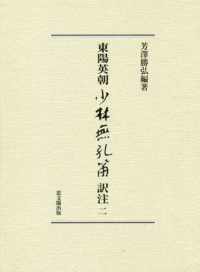- ホーム
- > 洋書
- > 英文書
- > Science / Mathematics
Full Description
Practical guide to structural stability theory for the design of safe steel structures
Not only does this book provide readers with a solid foundation in structural stability theory, it also offers them a practical, working knowledge of how this theory translates into design specifications for safe steel structures. Structural Stability of Steel features detailed discussions of the elastic and inelastic stability of steel columns, beams, beam-columns, and frames alongside numerous worked examples. For each type of structural member or system, the authors set forth recommended design rules with clear explanations of how they were derived.
Following an introduction to the principles of stability theory, the book covers:
*
Stability of axially loaded planar elastic systems
*
Tangent-modulus, reduced-modulus, and maximum strength theories
*
Elastic and inelastic stability limits of planar beam-columns
*
Elastic and inelastic instability of planar frames
*
Out-of-plane, lateral-torsional buckling of beams, columns, and beam-columns
The final two chapters focus on the application of stability theory to the practical design of steel structures, with special emphasis on examples based on the 2005 Specification for Structural Steel Buildings of the American Institute of Steel Construction. Problem sets at the end of each chapter enable readers to put their newfound knowledge into practice by solving actual instability problems.
With its clear logical progression from theory to design implementation, this book is an ideal textbook for upper-level undergraduates and graduate students in structural engineering. Practicing engineers should also turn to this book for expert assistance in investigating and solving a myriad of stability problems.
Contents
Chapter 1: Fundamentals of Stability Theory. Section 1.1 Introduction.
Section 1.2 Basics of Stability Behavior : The Spring-Bar System.
Section 1.3 Fundamentals of Post-Buckling Behavior.
Section 1.4 Snap-Through Buckling.
Section 1.5 Multi-Degree-of-Freedom Systems.
Section 1.6 Summary.
Problems.
Chapter 2: Elastic Buckling of Planar Columns.
Section 2.1 Introduction.
Section 2.2 Large-Deflection Solution of an Elastic Column.
Section 2.3 Differential Equation of Planar Flexure.
Section 2.4 The Basic Case: Pin-Ended Column.
Section 2.5 The Five Fundamental Cases.
Section 2.6 The Effect of Imperfections.
Section 2.7 Stability of A Rigid Frame.
Section 2.8 End-Restrained Columns.
Section 2.9 Restrained Column Examples.
Section 2.10 Continuously Restrained Columns.
Section 2.11 Summary.
Problems.
Appendix.
Chapter 3: Inelastic Column Buckling.
Section 3.1 The Tangent and Reduced Modulus Concepts.
Section 3.2 Shanley's Contribution.
Section 3.3 Example Illustrating the Tangent Modulus and the Reduced Modulus Concepts.
Section 3.4 Buckling Strength ff Steel Columns.
Section 3.5 Illustration Of The Effect of Residual Stresses on the Buckling Strength of Steel Columns.
Section 3.6 The Effect of Initial Out-of-Straightness and Load Eccentricity.
Section 3.7 Design Formulas For Metal Columns.
Section 3.8 Summary.
Problems.
Chapter 4: Beam-Columns.
Section 4.1 Introduction.
Section 4.2 General Discussion Of The Behavior Of Beam-Columns.
Section 4.3 The Elastic In-Plane Behavior Of Beam-Columns.
Section 4.4 Elastic Limit Interaction Relationships.
Section 4.5 Example Problems Of Beam-Column Strength.
Section 4.6 Systematic Methods Of Analysis: Flexibility Method.
Section 4.7 Systematic Methods Of Analysis: The Stiffness Method.
Section 4.8 Inelastic Strength Of Beam-Columns.
Section 4.9 Design Of Beam-Columns.
Problems.
Chapter 5: Frame-Stability.
Section 5.1 Introduction.
Section 5.2 Two-Bay Frame Examples.
Section 5.3 Summary.
Problems.
Chapter 6: Lateral-Torsional Buckling.
Section 6.1 Introduction.
Section 6.2 Basic Case: Beams Subjected To Uniform Moment.
Section 6.3 The Effect Of Boundary Conditions.
Section 6.4 The Effect Of Loading Conditions.
Section 6.5 Lateral-Torsional Buckling Of Singly-Symmetric Cross Sections.
Section 6.6 Beam-Columns And Columns.
Section 6.7 Inelastic Lateral-Torsional Buckling.
Section 6.8 Summary.
Problems.
Chapter 7: Bracing.
Section 7.1 Introduction.
Section 7.2 Discrete bracing.
Section 7.3 Relative Bracing.
Section 7.4 Lean-on Bracing.
Section 7.5 Effects of Imperfections.
Section 7.6 Column Bracing Provisions.
Section 7.7 Beam Bracing.
Section 7.8 AISC Design Provisions for Beam Bracing.
Section 7.9 Summary.
Suggested Reading.
Problems.
Chapter 8: Specification - Based Applications of Stability in Steel Design.
Section 8.1 Introduction.
Section 8.2 Development of the beam-column interaction equations.
Section 8.3 Assessment of Column Strength.
Section 8.4 Assessment of beam strength.
Section 8.5 Specification Based Approaches for Stability Assessment.
Section 8.6 Effective Length Factors, aka "K-factors".
Section 8.7 Design Assessment Example.
Section 8.8 Frame Design Requirements in Canada and Europe.
Section 8.9 Summary.
Problems.


















